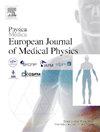Characterization and evaluation methods of fused deposition modeling and stereolithography additive manufacturing for clinical linear accelerator photon and electron radiotherapy applications
IF 3.3
3区 医学
Q1 RADIOLOGY, NUCLEAR MEDICINE & MEDICAL IMAGING
Physica Medica-European Journal of Medical Physics
Pub Date : 2025-02-01
DOI:10.1016/j.ejmp.2025.104904
引用次数: 0
Abstract
Purpose
To propose comprehensive characterization methods of additive manufacturing (AM) materials for MV photon and MeV electron radiotherapy.
Methodology
This study investigated 15 AM materials using CT machines. Geometrical accuracy, tissue-equivalence, uniformity, and fabrication parameters were considered. Selected soft tissue equivalent filaments were used to fabricate slab phantoms and compared with water equivalent RW3 phantom by delivering planar 6 & 10 MV photons and 6, 9, 12, 15, & 18 MeV electrons. Finally, a 3D printed CT-Electron Density characterization phantom was fabricated.
Results
Materials used to print test objects can simulate tissues from adipose (relative electron density, ) up to near inner bone-equivalent (). Lower densities such as breast and lung can be simulated using infills from 90 % down to 30 %, respectively. The gyroid infill pattern shows the lowest CT number variation and is recommended for low infill percentage printing. CT number uniformity can be observed from 40 % up to 100 % infill, while printing orientation does not significantly affect the CT number. The measured doses using the 3D printed phantoms show to have good agreement with TPS calculated dose for photon (< 1 % difference) and electron (< 5 % difference). Varying the printed slab thicknesses shows very similar response (< 3 % difference) compared with RW3 slabs except for 6 MeV electrons. Lastly, the fabricated CT-ED phantom generally matches the lung- up to the soft tissue- equivalence.
Conclusion
The proposed methods give the outline for characterization of AM materials as tissue-equivalent substitute. Printing parameters affect the radiological quality of 3D-printed object.
求助全文
约1分钟内获得全文
求助全文
来源期刊
CiteScore
6.80
自引率
14.70%
发文量
493
审稿时长
78 days
期刊介绍:
Physica Medica, European Journal of Medical Physics, publishing with Elsevier from 2007, provides an international forum for research and reviews on the following main topics:
Medical Imaging
Radiation Therapy
Radiation Protection
Measuring Systems and Signal Processing
Education and training in Medical Physics
Professional issues in Medical Physics.

 求助内容:
求助内容: 应助结果提醒方式:
应助结果提醒方式:


